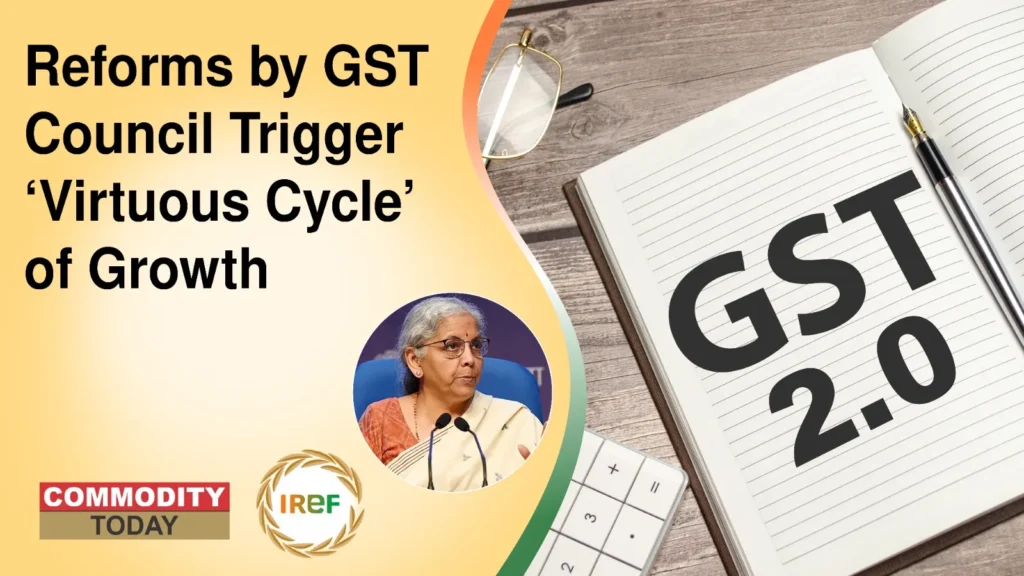Latest reforms by GST Council under the GST 2.0 framework have set in motion what the government calls a “virtuous cycle” of growth, driven by lower consumer prices and surging demand across key sectors. The GST 2.0 implementation date, September 22, marked a major shift in India’s indirect tax regime, as the GST Council reduced the number of tax slabs and slashed rates on hundreds of essential and consumer goods.
Union Finance Minister Nirmala Sitharaman said on Saturday that the rate rationalisation by GST Council has directly benefited consumers and boosted consumption-led growth. “The move to reduce tax rates ensures that the benefit of better tax collection reaches the common people,” she said at a press conference during the government’s ‘GST Bachat Utsav’ (GST Savings Festival), alongside Commerce Minister Piyush Goyal and Information & Broadcasting Minister Ashwini Vaishnaw.
GST 2.0 Implementation: Major Reforms by GST Council Across Categories
The GST Council, in its meeting on September 3, approved sweeping tax rate reductions on over 375 items, ranging from household essentials and medicines to automobiles and electronics. The four-slab structure—5%, 12%, 18%, and 28%—was streamlined into a two-tier system of 5% and 18%, with an additional 40% rate reserved for ultra-luxury items.
The new rates came into force on September 22, 2025, coinciding with the start of Navratri. The government estimated the move could cost the exchequer ₹48,000 crore annually but would stimulate demand and expand the tax base in the long term.
Consumption Surge Validates Strategy of GST Council
According to official data, India’s consumption has grown by nearly 10% year-on-year, translating to an additional ₹20 lakh crore in consumer spending this fiscal. Minister Vaishnaw highlighted that out of India’s ₹335 lakh crore GDP last year, ₹202 lakh crore came from consumption, and this year’s jump reflects the impact of the GST Council’s reforms.
The automobile industry recorded its best Navratri sales in a decade, with Maruti Suzuki delivering 165,000 cars in eight days and Tata Motors and Mahindra & Mahindra also reporting record sales. Consumer durables followed suit, with overall sales up 40–45%, and Haier witnessing an 85% growth in premium television sales. E-commerce platforms too saw unprecedented engagement, with Amazon India reporting 276 crore visits during the festive season—70% from Tier 2 and Tier 3 cities—further underscoring the widespread consumption revival.
Oversight of GST Council Ensures Benefits Reach Consumers
Sitharaman said the GST Council and the Department of Consumer Affairs are closely monitoring compliance to ensure companies pass on tax reduction benefits to consumers. Out of 3,169 complaints received about non-reduction in prices, 3,075 have been forwarded to the Central Board of Indirect Taxes and Customs (CBIC) for action.
She added that nearly all cement companies, barring a few exceptions, have reduced prices following the tax cut from 28% to 18%, reflecting high compliance across industries.
Virtuous Cycle’ of Growth and Investment
Piyush Goyal said the GST Council’s reforms have had a “multiplier effect” on business investment and industry output, boosting confidence among manufacturers. Sitharaman described this as a “virtuous cycle” — where lower taxes lead to higher consumption, which drives investment, creating jobs and sustained growth. With the GST 2.0 reforms fully in force since September 22, India’s indirect tax system has entered a new phase—simpler, consumer-friendly, and primed to fuel long-term economic expansion.



